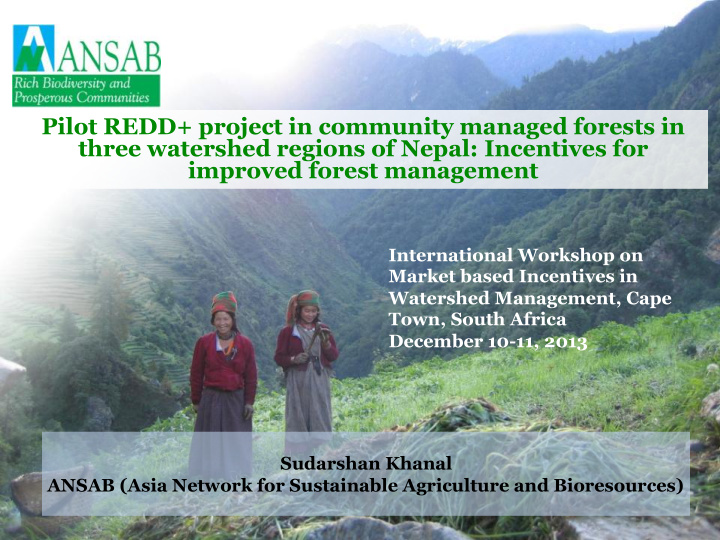



Pilot REDD+ project in community managed forests in three watershed regions of Nepal: Incentives for improved forest management International Workshop on Market based Incentives in Watershed Management, Cape Town, South Africa December 10-11, 2013 Sudarshan Khanal ANSAB (Asia Network for Sustainable Agriculture and Bioresources)
ANSAB Civil Society Organization, governed by an International Board, established in 1992 Works in South Asia & headquartered in Kathmandu, Nepal Vision: Rich biodiversity & prosperous communities Mission: Generate & implement community-based, enterprise- oriented solutions www.ansab.org
Setting the scene… REDD+ in CF REDD+ - an emerging market-based approach under the United Nations Framework Convention on Climate Change (UNFCCC) for reducing carbon emission Multiple co-benefits including reduced soil erosion, improved watershed conditions, increased fresh water supply, and enhanced potential for provision of other essential ecosystem Addresses the Resource use problems of watershed classified by FAO www.ansab.org
Setting the scene… REDD+ in CF Community forestry in Nepal is a successful global example of effective measure to retract or at least to reduce deforestation in mountainous landscape. Carbon payments may be seen as a co-benefit of successful community forestry activities that reduce carbon emission activities. www.ansab.org
Pilot REDD+ Project in Nepal NORAD funded project (2009-2013) Asia Network for Sustainable Agriculture and Bioresources (ANSAB), International Centre for Integrated Mountain Development (ICIMOD) and Federation of Community Forest Users, Nepal (FECOFUN) www.ansab.org
112 community forests in 3 watersheds www.ansab.org
www.ansab.org
Pilot-FCTF (Forest Carbon Trust Fund) US $ 100,000 Seed grant per year Multi-stakeholder – Government, civil society organizations, indigenous group organizations, private sectors 60% weightage – socio-economic parameters (10% for number of household of indigenous people, 15% for number of Dalit households, 15% for population of women in forest user groups, and 20% for the population of poor households) 40% for forest carbon (24% for stock and 16% for increment) www.ansab.org
FCTF Governance www.ansab.org
Forest Carbon Measurement www.ansab.org
Carbon enhancement Improved Forest Management & Protection Revision of community forest management plans and incorporation of REDD provisions Building capacity of communities for improved forest management and good governance Patrolling forest areas by forest guards and promoting social fencing Assisted Natural Regeneration Regulating free grazing and promote stall-feeding Removal of invasive species and weeds Controlling forest fire www.ansab.org
Afforestation and Reforestation Re-planting of indigenous tree species in denuded areas and other potential areas in CFs Growing bamboos and other fast growing species like Alder Reducing pressure on forest use Alternative energy promotion – biogas and improved cook stoves to reduce extraction of fuel wood from CFs Plantation of fast growing species ( Melia azadirachta, Bauhnia varigata etc. ) and grass and legume-based fodder in private land to meet communities’ firewood and fodder demand Support poor and marginalized in alternative livelihoods options, such as poultry, fishery, goat keeping, piggery, handicraft making and tailoring to reduce dependency on forest resources for their livelihoods www.ansab.org
REDD+ seed grant payment 2010 2011 2012 Watershed Average Average Average Carbon Carbon Carbon stock stock Payment stock Payment Ton carbon Ton carbon USD Ton carbon USD Charnawati 620,434 627,477 45,534.93 635,698.3 44,187.9 Ludhikhola 197,362 202,370 27,560.13 205,112.4 26,120.65 Kayarkhola 343,525 345,175 21,904.94 347,997.2 24,691.45 www.ansab.org
www.ansab.org
Payment in the project output Identify and periodic Review, adjust assessment of drivers of forest and adapt degradation, initiate forest enhancement activities Operate trust Establish baseline fund REDD of forest carbon payment and periodic disbursement monitoring Setting indicators/ criteria (social, biophysical) Standardized Frame Measurement, Develop Project Set up pilot trust measurement reporting and Design fund and methodologies Verification (MRV) Document (PDD) regulate REDD+ and guidelines system payment www.ansab.org
Limitations Performance on socio-economic parameters scored more than carbon performance Some CFUGs received multiple payments (same person as woman, poor and Dalit) www.ansab.org
Lessons learnt Linking community forestry and REDD+ offers an example of an effective, decentralized and sustainable system to achieve optimum outcomes for carbon, biodiversity and other ecosystem benefits. Forest user groups can themselves monitor and report on carbon stocks and increment. Engagement of local people in carbon monitoring helps to minimize cost and increases their ownership in whole process Maintaining social equity, especially ethnicity, gender and well-being, in benefit sharing is crucial for bringing positive change in the behavior of community members. www.ansab.org
Carbon stock and increment in community forests could be used, without socio-economic parameters, in the allocation of FCTF. The socio-economic factors should be considered only at the use of carbon money at CFUG level. Forest User Groups are prepared to co-fund activities that provide REDD+ co-benefits. www.ansab.org
Thank You! Visit www.ansab.org to ¡ Read our detailed capability statement ¡ Watch short documentaries about our work ¡ Consult more than 50 publications ¡ Subscribe to our newsletter, price list & more
Recommend
More recommend